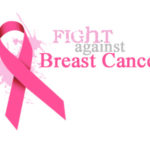
What is Breast Cancer?
The American Cancer Society explains that breast cancer is a malignant tumor that starts from cells of the breast. A malignant tumor is a group of cancer cells that may grow into (invade) surrounding tissues or spread (metastasize) to distant areas of the body. The disease occurs almost entirely in women, but men can get it, too.
The remainder of this document refers only to breast cancer in women. For information on breast cancer in men, see our document, Breast Cancer in Men.
The normal breast
To understand breast cancer, it helps to have some basic knowledge about the normal structure of the breasts, shown in the diagram below.
The female breast is made up mainly of lobules (milk-producing glands), ducts (tiny tubes that carry the milk from the lobules to the nipple), and stroma (fatty tissue and connective tissue surrounding the ducts and lobules, blood vessels, and lymphatic vessels).
Most breast cancers begin in the cells that line the ducts (ductal cancers). Some begin in the cells that line the lobules (lobular cancers), while a small number start in other tissues.
The lymph (lymphatic) system
The lymph system is important to understand because it is one of the ways in which breast cancers can spread. This system has several parts.
Lymph nodes are small, bean-shaped collections of immune system cells (cells that are important in fighting infections) that are connected by lymphatic vessels. Lymphatic vessels are like small veins, except that they carry a clear fluid called lymph (instead of blood) away from the breast. Lymph contains tissue fluid and waste products, as well as immune system cells. Breast cancer cells can enter lymphatic vessels and begin to grow in lymph nodes.
Most lymphatic vessels in the breast connect to lymph nodes under the arm (axillary nodes). Some lymphatic vessels connect to lymph nodes inside the chest (internal mammary nodes) and those either above or below the collarbone (supraclavicular or infraclavicular nodes).
It is important to find out if the cancer cells have spread to lymph nodes because if they have, there is a higher chance that the cells could have also gotten into the bloodstream and spread (metastasized) to other sites in the body. The more lymph nodes that have breast cancer, the more likely it is that the cancer may be found in other organs as well. This is important to know because it could affect your treatment plan. Still, not all women with cancer cells in their lymph nodes develop metastases, and some women can have no cancer cells in their lymph nodes and later develop metastases

Benign breast lumps
Most breast lumps are not cancerous (benign). Still, some may need to be sampled and viewed under a microscope to prove they are not cancer.
Fibrocystic changes
Most lumps turn out to be fibrocystic changes. The term fibrocystic refers to fibrosis and cysts. Fibrosis is the formation of scar-like (fibrous) tissue, and cysts are fluid-filled sacs. Fibrocystic changes can cause breast swelling and pain. This often happens just before a woman’s menstrual period is about to begin. Her breasts may feel lumpy and, sometimes, she may notice a clear or slightly cloudy nipple discharge.
other benign breast lumps
Benign breast tumors such as fibroadenomas or intraductal papillomas are abnormal growths, but they are not cancerous and do not spread outside of the breast to other organs. They are not life threatening. Still, some benign breast conditions are important because women with these conditions have a higher risk of developing breast cancer.
For more information see the section, “What are the risk factors for breast cancer?” and our document, Non-cancerous Breast Conditions.
General breast cancer terms
It is important to understand some of the key words used to describe breast cancer.
Carcinoma
This is a term used to describe a cancer that begins in the lining layer (epithelial cells) of organs like the breast. Nearly all breast cancers are carcinomas (either ductal carcinomas or lobular carcinomas).
Adenocarcinoma
An adenocarcinoma is a type of carcinoma that starts in glandular tissue (tissue that makes and secretes a substance). The ducts and lobules of the breast are glandular tissue (they make breast milk), so cancers starting in these areas are often called adenocarcinomas.
Carcinoma in situ
This term is used for the early stage of cancer, when it is confined to the layer of cells where it began. In breast cancer, in situ means that the cancer cells remain confined to ducts (ductal carcinoma in situ) or lobules (lobular carcinoma in situ). They have not grown into (invaded) deeper tissues in the breast or spread to other organs in the body. Carcinoma in situ of the breast is sometimes referred to as non-invasive or pre-invasive breast cancer.
Invasive (infiltrating) carcinoma
An invasive cancer is one that has already grown beyond the layer of cells where it started (as opposed to carcinoma in situ). Most breast cancers are invasive carcinomas — either invasive ductal carcinoma or invasive lobular carcinoma.
Sarcoma
Sarcomas are cancers that start from connective tissues such as muscle tissue, fat tissue, or blood vessels. Sarcomas of the breast are rare.
h nodes and later develop metastases

Types of breast cancers
There are several types of breast cancer, but some of them are quite rare. In some cases a single breast tumor can have a combination of these types or have a mixture of invasive and in situ cancer.
Ductal carcinoma in situ
Ductal carcinoma in situ (DCIS; also known as intraductal carcinoma) is the most common type of non-invasive breast cancer. DCIS means that the cancer cells are inside the ducts but have not spread through the walls of the ducts into the surrounding breast tissue.
About 1 in 5 new breast cancer cases will be DCIS. Nearly all women diagnosed at this early stage of breast cancer can be cured. A mammogram is often the best way to find DCIS early.
When DCIS is diagnosed, the pathologist (a doctor specializing in diagnosing disease from tissue samples) will look for areas of dead or dying cancer cells, called tumor necrosis, within the tissue sample. If necrosis is present, the tumor is likely to be more aggressive. The term comedocarcinoma is often used to describe DCIS with necrosis.
Lobular carcinoma in situ
Although it is not a true cancer, lobular carcinoma in situ (LCIS; also called lobular neoplasia) is sometimes classified as a type of non-invasive breast cancer, which is why it is included here. It begins in the milk-producing glands but does not grow through the wall of the lobules.
Most breast cancer specialists think that LCIS itself does not become an invasive cancer very often, but women with this condition do have a higher risk of developing an invasive breast cancer in the same breast or in the opposite breast. For this reason, women with LCIS should make sure they have regular mammograms and doctor visits.
Invasive (or infiltrating) ductal carcinoma
This is the most common type of breast cancer. Invasive (or infiltrating) ductal carcinoma (IDC) starts in a milk passage (duct) of the breast, breaks through the wall of the duct, and grows into the fatty tissue of the breast. At this point, it may be able to spread (metastasize) to other parts of the body through the lymphatic system and bloodstream. About 8 of 10 invasive breast cancers are infiltrating ductal carcinomas.
Invasive (or infiltrating) lobular carcinoma Invasive lobular carcinoma (ILC) starts in the milk-producing glands (lobules). Like IDC, it can spread (metastasize) to other parts of the body. About 1 out of 10 invasive breast cancers is an ILC. Invasive lobular carcinoma may be harder to detect by a mammogram than invasive ductal carcinoma.
Less common types of breast cancer
Inflammatory breast cancer
This uncommon type of invasive breast cancer accounts for about 1% to 3% of all breast cancers. Usually there is no single lump or tumor. Instead, inflammatory breast cancer (IBC) makes the skin of the breast look red and feel warm. It also gives the breast skin a thick, pitted appearance that looks a lot like an orange peel. Doctors now know that these changes are not caused by inflammation or infection, but by cancer cells blocking lymph vessels in the skin. The affected breast may become larger or firmer, tender, or itchy. In its early stages, inflammatory breast cancer is often mistaken for an infection in the breast (called mastitis). Often this cancer is first treated as an infection with antibiotics. If the symptoms are caused by cancer, they will not improve, and the skin may be biopsied to look for cancer cells. Because there is no actual lump, it may not show up on a mammogram, which may make it even harder to find it early. This type of breast cancer tends to have a higher chance of spreading and a worse outlook than typical invasive ductal or lobular cancer. For more details about this condition, see our document, Inflammatory Breast Cancer.
Triple-negative breast cancer
This term is used to describe breast cancers (usually invasive ductal carcinomas) whose cells lack estrogen receptors and progesterone receptors, and do not have an excess of the HER2 protein on their surfaces. (See the section, “How is breast cancer diagnosed?” for more detail on these receptors.) Breast cancers with these characteristics tend to occur more often in younger women and in African-American women. Triple-negative breast cancers tend to grow and spread more quickly than most other types of breast cancer. Because the tumor cells lack these certain receptors, neither hormone therapy nor drugs that target HER2 are effective against these cancers (but chemotherapy can still be useful if needed).
Mixed tumors
Mixed tumors contain a variety of cell types, such as in
How to Examine Your Breasts Properly
Excerpt from ezine articles
type=textBreast self-examination is a very simple procedure which women can perform in the confines of the bedrooms or bathrooms. This test is a very important self diagnostic tool to determine the risks of breast cancer. Nowadays, doctors are emphasizing on the point that each woman should perform breast self-examinations regularly so that they can find out if there are any abnormalities in their breasts.
One important factor that is in favor of breast self-examination is that no one will know her breasts as accurately as the woman herself. Doctors are encouraging women to become more familiarized with their own breasts so that they can immediately find out any abnormalities. Women should know the contours, the feel, the texture and the color of their breasts perfectly. This is an important part of the breast self-examination technique.
How to Self-Examine the Breasts
The first part of self-examination of the breasts is pure observation. The woman must remove her upper body garment and stand in front of a mirror. Then she should place her hands by her sides. The next step is observation of the breasts. For this, the woman must first observe her breasts in their frontal positions, then turn to the left and right sides and observe the breasts from those sides in the mirror. This observation must be repeated with the hands on the hips and finally with the hands placed over the head. Any abnormality in the breast must be noted.
The next stage of breast self-examination is actually touching the breast to find out any abnormalities. There are two methods to carry out this part of the self-examination.
(i) Circular Sweep Method
For this method, the left hand is to be placed behind the head and the right hand is used to touch different parts of the breasts. Women who are more comfortable with the right hand behind the head and the left hand touching the breasts may do so. The free hand must be kept on the top of the breast region, just where the bulge begins. Then the hand is to be moved gradually in a clockwise manner, feeling the breast carefully at each point for lumps or any other kind of deformities. When one circle is completed, the hand must be taken a little inside the breast and the circular sweep must be done again. In this way, the circle must be progressively decreased until the hand reaches the nipple area. At every point gentle but steady pressure must be applied to check that there are no anomalies in the breasts. Finally, when the hand reached the nipple tissue, the fingers must be used to squeeze the nipple in both vertical and horizontal positions to check if there is any secretion.
(ii) Pie Chart Method
Here too, the woman self-examining her breasts needs to keep one hand behind her head and examine the breasts with the other hand. The hand is to be placed on the top region of the breast and then swept downwards, towards the protuberance of the nipple. Along the way, the fingers must be used to check if there are any lumps in the breast. When the hand reaches the nipple after one sweep, then it must be taken to the top again, placed a little to the left and swept downwards again. In this manner, the whole breast must be covered, even from the lower region, checking every point. If a firmer touch is required, then the fingers can be moved in a walking type of motion over the breast. Again, this examination must be ended with a pinching of the nipples in both vertical and horizontal directions to check for any abnormal secretion.
Age to Begin Breast Self-Examination
Hormonal changes begin occurring from the onset of puberty, i.e. when the girl reaches twelve years of age in normal circumstances. When the girl is in her post-puberty, which is roughly twenty years, the estrogen amounts have generally built up to their maturity levels. This is when breast self-examination must begin.
The breast self-examination must be carried out as a routine procedure. In fact every woman who has crossed the age of twenty years must carry out the examination once a month while in the shower. When the woman has crossed the age of forty years, then only breast self-examination is not enough. At that time, the woman must have a mammogram taken at least once a year.
The Best Time to Self-Examine the Breasts
Breasts are prone to undergo several changes within the menstrual cycle of the woman. At some times during the cycle, the breasts are soft; while at some other times, they may be firm. This happens generally in the later days of the menstrual cycle. When the breasts are firm, it is more difficult to check them for any lumpy growths. Therefore, the ideal time for carrying out breast self-examination would be one week after the menstrual flow has occurred.








